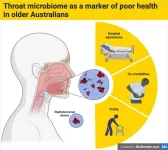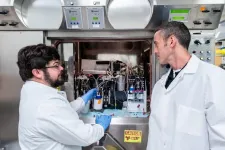(Press-News.org) A new discovery about how tiny protein clusters form in cells could pave the way for treatments for Emery-Dreifuss muscular dystrophy (EDMD), a rare genetic disorder that causes muscle weakness and heart problems.
Researchers at the USC Dornsife College of Letters, Arts and Sciences combined advanced imaging techniques and theoretical physics to observe and explain how nanoclusters of the protein emerin form inside living cells. These clusters — about 100,000 times smaller than a human hair’s width — play a crucial role in how cells sense and respond to mechanical forces like stretching or pressure, a process known as mechanotransduction. When this process fails, it can contribute to diseases like muscular dystrophy.
The study, published in Physical Review Research, uncovers the molecular “rules” driving the arrangement of emerin into nanoclusters and the mechanisms leading to their defective assembly in people with EDMD. By identifying the physical principles behind those defects and why they disrupt mechanotransduction and trigger disease symptoms, scientists hope to develop new strategies to correct them.
Fascinatingly, the researchers, led by Christoph Haselwandter, professor of physics and astronomy and quantitative and computational biology, and Fabien Pinaud, associate professor of biological sciences and physics and astronomy, applied principles first proposed by Alan Turing — the famed WWII codebreaker and computing pioneer — to understand how these nanoclusters form. Turing’s work on pattern formation in nature(such as zebra stripes and leopard spots) revealed mathematical rules that also appear to govern protein assembly at a nanoscale level.
“This research opens up exciting possibilities,” said study first author Carlos Alas, who earned his physics PhD in 2023 from USC Dornsife. “By applying physics-based approaches, we can start thinking about ways to correct these defects and potentially help people with this debilitating disease.”
While the findings focus on muscular dystrophy, understanding how proteins like emerin function could also lead to breakthroughs in other diseases linked to cellular mechanics.
About the study
In addition to Haselwandter, Pinaud and Alas, USC Dornsife PhD student Liying Wu also contributed to the research.
END
Scientists unlock clues to new treatments for muscular dystrophy
A new discovery about how tiny protein clusters form in cells could pave the way for treatments.
2025-03-06
ELSE PRESS RELEASES FROM THIS DATE:
Anti-obesity drugs benefit kidney transplant recipients with type 2 diabetes
2025-03-06
Kidney transplant recipients with type 2 diabetes treated with a new class of anti-obesity drugs were less likely to experience organ failure and survived longer, a new study shows. Not only is obesity a known risk factor for diabetes, but it also increases risk of postsurgical complications, such as inflammation, organ rejection, and early death.
Previous research had suggested some benefit for kidney transplant recipients with a history of type 2 diabetes who took the medications, originally designed to treat diabetes, at some point after their transplant ...
Cases of Parkinson’s disease set to reach 25 million worldwide by 2050
2025-03-06
By 2050, there will be 25.2 million people living with Parkinson’s disease worldwide (a 112% increase from 2021), largely due to population ageing, suggests a modelling study published by The BMJ today.
Overall, the number of people living with Parkinson’s disease (all age prevalence) per 100,000 population is predicted to increase by 76%, and by 55% when corrected for age differences (age standardised prevalence), with rates projected to be highest in East Asia.
The researchers say these projections “could serve as an aid in promoting health research, ...
Throat microbiome holds clues to older Australians’ health
2025-03-06
New research by Flinders University has uncovered a potential marker that could provide valuable insights into the overall health of older adults living in long-term aged care facilities.
Led by PhD candidate Sophie Miller in the College of Medicine and Public Health, the study found that a simple swab from the back of the throat, known as the oropharynx, may offer clues about health challenges faced by aged care residents.
“Our findings suggest that certain bacteria detected in the back of the throat could indicate greater health vulnerability in older adults,” says Miller.
Identifying vulnerable individuals ...
Diabetes drug could help cancer patients make better recovery
2025-03-06
A common type of diabetes medication could help cancer patients make a better long-term recovery, according to new research from the University of East Anglia.
Many cancer patients go on to develop heart failure - because of the cancer itself and also due to chemotherapy. This can lead to a reduced quality of life, multiple admissions to hospital or even death.
But a new study published today shows that a type of diabetes medication, called an SGLT2 inhibitor, may help protect the ...
Seismic study of Singapore could guide urban construction and renewable energy development
2025-03-05
A new seismic study of Singapore could guide urban growth and renewable energy development in the coastal city nation, where 5.6 million residents live within an area of 734 square kilometers.
The study, published in Seismological Research Letters, identifies areas with increased risk of ground shaking and a possible reservoir for geothermal energy production, as well as a glimpse at Singapore’s tectonic history.
Jiayuan Yao of China University for Geosciences and colleagues analyzed teleseismic data captured by a few permanent seismic stations and a nodal seismic array deployed in 2019 around the city. Their results provide the first detailed look at the top-kilometer ...
Tufts scientists develop open-source software for modeling soft materials
2025-03-05
When mechanical and structural engineers design machines, bridges, and buildings, they calculate loads, stresses, and deformation of metal, steel, concrete, glass, wood, and plastic to find the optimal geometry that bears loads with the minimum cost of material.
Designing for relatively hard materials that do not deform too much is commonly handled by software that calculates and optimizes structures using mathematical models that are well understood and easily applied.
But there is an expanding class of design challenges for things that incorporate soft materials—biological materials, engineered tissues, membranes, and even shape-shifting ...
Repurposed ALS drug becomes imaging probe to help diagnose neurodegeneration
2025-03-05
Positron emission tomography (PET) is a nuclear imaging technique used to diagnose conditions such as cancer. An innovative advance from scientists at St. Jude Children’s Research Hospital is enhancing the technique’s ability to check for signs of neurological disease. The researchers repurposed the drug edaravone, an antioxidant used to treat amyotrophic lateral sclerosis (ALS), as a probe to be used with central nervous system PET imaging. With this technique, the researchers can ...
AI can open up beds in the ICU
2025-03-05
At the height of the COVID-19 pandemic, hospitals frequently ran short of beds in intensive care units. But even earlier, ICUs faced challenges in keeping beds available. With an aging American population, 11% of hospital stays included ICU stays.
Artificial intelligence offers a possible solution, says Indranil Bardhan, professor of information, risk, and operations management and Charles and Elizabeth Prothro Regents Chair in Health Care Management at Texas McCombs. AI models can predict the lengths of time patients will spend in the ICU, helping hospitals better manage their beds and, ideally, cut costs.
But although AI is good at predicting length of stay, ...
Are robotic hernia repairs still in the “learning curve” phase?
2025-03-05
For an abdominal wall hernia repair, also known as a ventral hernia repair, the most common surgical approaches have been laparoscopic and open techniques.
But a new approach for repairing hernias has been steadily growing in popularity: the surgical robot.
Supporters of using the robot method state multiple advantages over traditional laparoscopic and open approaches, including improved surgeon ergonomics.
But there may be downsides to the technology that are going undiscussed.
In a research article published in JAMA Surgery, Brian Fry, M.D., M.S., a ...
New STI impacts 1 in 3 women: Landmark study reveals men are the missing link
2025-03-05
A landmark study reveals that bacterial vaginosis (BV), a condition affecting nearly a third of women worldwide and causing infertility, premature births and newborn deaths, is in fact a sexually transmitted infection (STI), paving the way for a revolution in how it is treated.
Monash University and Alfred Health researchers at the Melbourne Sexual Health Centre say their findings, published today in the New England Journal of Medicine, hold the key to driving down stubborn and distressing recurrence ...
LAST 30 PRESS RELEASES:
Signature patterns of brain activity may help predict recovery from traumatic brain injury
Dresden study uncovers new key mechanism in cancer cells
New species are now being discovered faster than ever before, study suggests
Cannabis-based products show limited short-term benefit for chronic pain, with increased risk of adverse effects
Cannabis products with more THC slightly reduce pain but cause more side effects
Clearing the brain of aging cells could aid epilepsy and reduce seizures
Brain injuries linked with potential risk of suicide, new study finds
New technique lights up where drugs go in the body, cell by cell
New study finds movement of fishing fleets can reveal shifts in marine ecosystems
Embargoed: New evidence points to potential treatment for vascular dementia
Study uncovers disrupted brain balance in alcohol dependence
Working in groups can help Republicans and Democrats agree on controversial content moderation online
Structural findings reveal how distinct GPCR ligands create different levels of activation
Anything-goes “anyons” may be at the root of surprising quantum experiments
UC review: Maximizing workplace opportunity for veterans
From generation to complex control: Metasurfaces make perfect vortex beams "within reach"
Thin-film lithium niobate-based detector: recent advances and perspectives
Exploring why some people may tend to persistently make bad choices
How cells balance their protein levels
Nirsevimab vs RSVpreF vaccine for RSV–related hospitalization in newborns
Effectiveness and impact of maternal RSV immunization and nirsevimab on medically attended RSV in US children
AI gives scientists a boost, but at the cost of too many mediocre papers
Next-generation vision model maps tree growth at sub-meter precision
Genes aren’t destiny for inherited blindness, study shows
MIT study: High-fat diets make liver cells more likely to become cancerous
Exposure to multiple fine particulate matter components and incident depression in the US Medicare population
Risk of burdensome health care spending over time in the US
Nirsevimab against hospitalizations and emergency department visits for lower respiratory tract infection in infants
New microfluidics technology enables highly uniform DNA condensate formation
A new strategy for immune tolerance
[Press-News.org] Scientists unlock clues to new treatments for muscular dystrophyA new discovery about how tiny protein clusters form in cells could pave the way for treatments.



